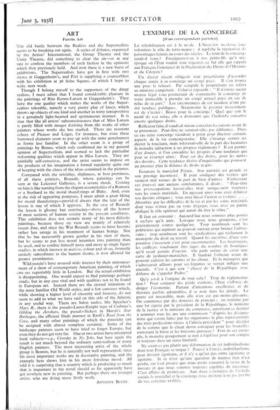ART
Furrin Art
THE old battle between the Realists and the Superrealists seems to be breaking out again. A series of debates, organised by the Artists' International, the Group Theatre and the Unity Theatre, did something to clear the air—or at any rate to confirm the members of each faction in the opinions which they previously held. And now there is a new burst of exhibitions. The Superrealists have got in first with two shows at Guggenheim's, and Peri is supplying a counterblast with his exhibition at 36 Soho Square, of which I hope to write next week.
Though I belong myself to the supporters of the dingy realists, I must admit that I found considerable pleasure in the paintings of Rita Kernn-Larsen at Guggenheim's. They have the one quality which makes the works of the Super- realists tolerable, namely a very pretty play of fancy, which throws up objects of one kind and another in witty juxtaposition in a genuinely light-hearted and spontaneous manner. It is true that like all artists' subconsciousness that of Miss Larsen is partly filled with images deriving from the works of other painters whose works she has studied. There are resonant echoes of Picasso and Leger, for instance, but even these borrowed elements seem to pop up with the same genuineness as forms less familiar. In the other room is a group of paintings by Benno, which only confirmed me in my general opinion of Superrealism, and seemed to lack the particular redeeming qualities which appear in Miss Larsen. They are painfully self-conscio-as, and the artist seems to impose on the products of his imagination a formal regularity quite out of keeping with the chaos of the ideas contained in the pictures.
Compared with the triviality, slightness, at best prettiness, of all these painters, Rouault, whose paintings can be seen at the Leicester Galleries, is a severe shock. Coming on him is like turning from the elegant eccentricities of a Romney or a Stothard to the moral thunthrings of Blake. And, even at the risk of appearing pompous, I must admit a great liking for moral thunderings—provided always that the text of the lesson is one of which I approve. In the case of Rouault the lesson is gloomy but convincing—above all the horror of most sections of human society in the present conditions. This exhibition does not contain many of his most didactic paintings, because those on view are mainly of relatively recent date, and since the War Rouault seems to have become rather less savage in his treatment of human beings. Not that he has necessarily grown gentler in his view of them, but he seems to put less moral intention into painting than he used, and to confine himself more and more to single figure studies, in which interest in matiere, colour and so on, formerly entirely subordinate to the human theme, is now allowed far greater prominence.
Wildenstein's have aroused wide interest by their announce- ment of a show of contemporary American painting, of which we see regrettably little in London. But the actual exhibition is disappointing. One would expect to find paintings perhaps crude, but in any case vital and with qualities not to be found in European art. Instead there are the eternal imitations of the most familiar Old World styles, and a few canvases which, while showing a higher level of sincerity and honesty, do not seem to add to what we have said on this side of the Atlantic in any useful way. There are Salon nudes, like Speicher's Mary R., there is the pseudo-Laura-Knight type of Cadmus's Gilding the Acrobats, the pseudo-Sicken in Marsh's Star Burlesque, the efficient Slade manner in Kroll's Road from the Cove, and many other paintings of which the paternity can be assigned with almost complete certainty. Some of the landscape painters seem to have tried to forget Europe, but even they do not get very far. One or two artists have attempted local subjects—e.g., Civosky in No gobs, but here again the result is not much beyond the ordinary semi-realism of many English painters. The most interesting artist of the whole group is Benton, but he is naturally not well represented, since his most important works are in decorative painting, and the example here shows him in his more frivolous mood. All told it is surprising that a country which is producing so much that is important in the novel should so far apparently have got nowhere new in painting. But perhaps there are younger artists who are doing more lively work.
ANTHONY BLUNT.


















































 Previous page
Previous page